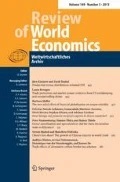
Lo más reciente
A new set of tools to measure the time stationarity, shape and ordinal ranking bias of Revealed Comparative Advantage (RCA) indexes is suggested. The aim is to help select the most consistent RCA index for a given set of countries, products and time periods, which is especially relevant for economic policy based on comparative advantages. The GMM estimation of an AR(1) process based on RCA indexes provides three measures of time stationarity that are more rational than the measures available in the literature. Furthermore, we revise the statistics that are commonly used to capture shape. Finally, with respect to ordinal ranking bias, we modify the use of Spearman’s rank correlation coefficient in Leromain and Orefice (Int Econ 139:48–70, 2014) and generalize the non-parametric measure of Stellian and Danna-Buitrago (J Appl Econ 22(1):349–379, 2019). We discuss different methods of ranking RCA indexes according to all proposed measures. An application to 33 RCA indexes, 67 trade areas and three product classifications shows that, on average, the most accurate RCA indexes are Contribution-to-the-Trade-Balance indexes, Revealed Competitiveness indexes and regression-based indexes.
